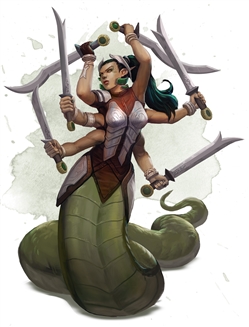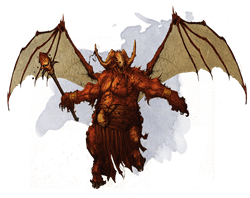Spell Spotlight: Forbiddance
Forbiddance is a spell in the Player’s Handbook that I doubt most Dungeons & Dragons players have ever heard of, let alone cast. This Spell Spotlight is the story of how one spell utterly broke an adventure I wrote and had published in the D&D Adventurer’s League, and how I managed to fix it.

What Does Forbiddance Do?
Before we get into this story, we need to make it clear what forbiddance can actually do. It’s a fairly innocuous spell at first glance. By spending 10 minutes to cast this 6th-level spell, you can ward up to 40,000 square feet of floor space against planar travel, and against a specific type of supernatural creature—celestials, elementals, fey, fiends, or undead. It also lasts 24 hours, and can be made permanent (until dispelled) by casting it every day for 30 days.
Essentially, forbiddance is a spell with a very specific function: to protect an area, generally your home base or any other location you need to protect for a significant amount of time. It even lets you create a password, just in case you’re fighting against demons and need to let a devil ally inside the warded area. (Stranger things have happened in the Blood War!)
However, if you aren’t careful, this seemingly defensive spell can be turned into an incredible offensive force—one that can purge dungeons in mere moments.
Fire, Ash, and Ruin: Bug-Bombing a Dungeon
 High-level play is hard to design for. The player characters have grown so powerful over the course of their adventuring career by 13th level or so that it’s hard to know what will actually challenge them anymore. This is true for home D&D games when you’re designing for players you’re familiar with, but it’s even more relevant to designers who are creating dungeons for 3 to 7 characters with unknown class combinations and a wide range of levels.
High-level play is hard to design for. The player characters have grown so powerful over the course of their adventuring career by 13th level or so that it’s hard to know what will actually challenge them anymore. This is true for home D&D games when you’re designing for players you’re familiar with, but it’s even more relevant to designers who are creating dungeons for 3 to 7 characters with unknown class combinations and a wide range of levels.
With that in mind, my first foray into high-level adventure design was a train wreck. I designed an adventure titled Fire, Ash, and Ruin for the seventh season of the D&D Adventurer’s League, which complemented the Tomb of Annihilation storyline. In this adventure, 3 to 7 player characters of 11 to 16th level ventured into the Land of Ash and Smoke, a region of Chult dominated by ash fields and active volcanoes. Within the Land of Ash and Smoke was an abyssal void known as the Pit of Krahharu, a dungeon filled with demons and ruled by a balor—Immilor, Lord of Blue Flames.
I made a lot of rookie mistakes in this adventure, including everything from making the fights too easy to making sweeping assumptions about party composition. But taken on their own “merits,” no single mistake in Fire, Ash, and Ruin was as damning as failing to account for one spell: forbiddance.
The Pit of Krahharu’s dungeon level was a sprawling, labyrinthine complex filled with demons. Every single enemy in the dungeon was a fiend, from the lowliest minion to the dungeon’s commander: Immilor the balor. Maybe you can see the problem. By spending just 10 minutes of casting, a party with a cleric could cast forbiddance offensively, so long as they possessed the 1,000 gp material component. The spell would affect the entire dungeon with its 40,000 square-foot affected area, and by selecting fiends as the warded creature type, every single creature in the dungeon took 5d10 radiant damage every 6 seconds.
One cleric could just spend a 6th-level spell slot to fumigate the entire dungeon from the entrance. My poor demons never stood a chance.
I have to congratulate players who used this strategy for clever thinking. Using a defensive spell like forbiddance as a monstrously effective offensive tool is something I would applaud in my home games. In a home game, exploiting my errors is something I reward. Even at so great a scale, I would be happy that my players found a way to overwhelm my challenges. But that’s in a home game, a place where I can improvise new challenges on the fly in order to prevent a moment of triumph from becoming an anti-climax.
Published adventures are different. When this sort of error happens in a published adventure, it’s on other people to salvage an anti-climax themselves. Normally I’m happy to trust other DMs’ ingenuity, but in the Adventurer’s League, where strict rules-adherence is the norm and wild, frantic improvisation is a bug, not a feature? This sort of glitch doesn’t fly in that environment.
Fire, Ash, and Ruin v1.1: Saving a Disastrous Dungeon
 Fire, Ash, and Ruin released to dismal reviews, but I fortunately had the chance to collect dozens of players’ feedback and create a revised version with its major glitches fixed. Some of these fixes were as simple as cutting mediocre content (like the boring wilderness exploration section at the beginning), while others were as complex as rewriting entire encounters.
Fire, Ash, and Ruin released to dismal reviews, but I fortunately had the chance to collect dozens of players’ feedback and create a revised version with its major glitches fixed. Some of these fixes were as simple as cutting mediocre content (like the boring wilderness exploration section at the beginning), while others were as complex as rewriting entire encounters.
Beyond simple fixes and complex fixes, however, is the elegant solution. In layman’s terms, an elegant solution is killing two (or three, or four) birds with one stone. In this situation, “an elegant solution” refers to solving a problem by using interactions already present within the game’s rules, rather than creating a new rule to fix a bug or an exploit. Game designers get high off of creating elegant solutions. It’s the game designer equivalent to the dopamine rush a player gets when their cleric kills every demon inside a dungeon by casting a single spell.
Suffice it to say, I’m proud of my solution to my forbiddance problem, and I hope my solution helps you with your own design. I solved it by creating a forbiddance of my own.
There’s a fairly innocuous line in the spell text of forbiddance. It reads: “The spell's area can't overlap with the area of another forbiddance spell.” It makes sense that the spells can’t overlap, otherwise a clever player or NPC could create an area of instant death (read, thousands of d10 worth of radiant damage per round) by stacking hundreds of castings of forbiddance in a single area.
I saved my dungeon from anti-fiend fumigation by proactively forbidding it against celestials. It’s thematic—a pit filled with demons wouldn’t want angels teleporting in and trashing the place—but more importantly, it prevents the player characters from forbidding the demons’ own lair against them, since separate castings of that spell can’t overlap.
Forbiddance in Your Game
I wasn’t even aware forbiddance existed when I wrote Fire, Ash, and Ruin. Lesson learned; if you can’t memorize every spell in the game, then playtest your adventures again and again and again. I hope you can learn from my mistakes—I did!
Characters who can cast forbiddance are rare; only clerics of 11th level or higher can cast this elusive spell. If you happen to be running a game with an 11th-level cleric, consider safeguarding your dungeons against offensive castings of forbiddance by:
- Proactively creating a forbiddance of your own, or
- Simply diversifying your enemy types.
Even in a demon-themed dungeon, I could have included enemies that weren’t fiends. Elementals corrupted by demonic power (which I included in the upper levels of the dungeon), crazed cultists, undead spawn of Orcus, mind-controlled illithids… the list goes on. Diversifying your monster roster protects against all sorts of spells and effects, not just forbiddance. It can make your dungeon stronger against a paladin’s Divine Smite, a cleric’s Turn Undead, a ranger’s Favored Enemy and Primeval Awareness, and all a dozen other traits.
Creating dungeons filled with diverse, yet still thematic enemies is a DM’s most elegant possible defense against spells that target entire groups of creatures like protection against evil and good and forbiddance. What other solutions have you come up with?
 James Haeck is the lead writer for D&D Beyond, the co-author of the Critical Role Tal'Dorei Campaign Setting, and a freelance writer for Wizards of the Coast, the D&D Adventurers League, and Kobold Press. He lives in a five-room apartment/dungeon in Seattle, Washington with his partner Hannah and his two kitties—who are FORBIDDEN from jumping on the table!—Mei and Marzipan. You can usually find him wasting time on Twitter at @jamesjhaeck.
James Haeck is the lead writer for D&D Beyond, the co-author of the Critical Role Tal'Dorei Campaign Setting, and a freelance writer for Wizards of the Coast, the D&D Adventurers League, and Kobold Press. He lives in a five-room apartment/dungeon in Seattle, Washington with his partner Hannah and his two kitties—who are FORBIDDEN from jumping on the table!—Mei and Marzipan. You can usually find him wasting time on Twitter at @jamesjhaeck.








-
View User Profile
-
Send Message
Posted May 16, 2018Oof, I'm playing in this adventure on Saturday. Guess I'll come back and read this Sunday....
-
View User Profile
-
Send Message
Posted May 16, 2018A side note: the material is only consumed if you make the effect permanent. A "trivial cast" (if I can use trivial to describe a 6th level spell) of it, doesn't consume the material.
-
View User Profile
-
Send Message
Posted May 16, 2018"Game designers get high off of creating elegant solutions. It’s the game designer equivalent to the dopamine rush a player gets when their cleric kills every demon inside a dungeon by casting a single spell."
So true! Thanks for the insight, James.
-
View User Profile
-
Send Message
Posted May 16, 2018Great insight into a neat spell. Thanks, James.
-
View User Profile
-
Send Message
Posted May 16, 2018Another fix you could do for the spell is to just make it so that the damage effect doesn't effect creatures already in the area when you cast it.
-
View User Profile
-
Send Message
Posted May 16, 2018Your solution is nice, but wouldn't necessarily work. Clerics also know dispel magic.
-
View User Profile
-
Send Message
Posted May 16, 2018In Adventurer's League, how strict are we on the getting of spell components? I mean, even for an 11th level adventurer, getting their hands on 1,000 gp worth of powdered ruby should not be that common, right?
-
View User Profile
-
Send Message
Posted May 16, 2018"What other solutions have you come up with?"
Casting Dispel Magic or Counterspell. All you need is ONE monster in the entire dungeon to be able to cast it to ruin the forbiddance plan.
The demons sense the oncoming radiant power and quickly start hunting for those who are invoking the magic, launching an attack. Detect Magic is a thing on more than one fiend, plus I'd say that Arcana/Religion checks should be possible.
Scouts, guards and others. I'm sorry, but casting a spell for ten minutes is hardly stealthy, and there's lots of chances to stumble upon the ritual.
-
View User Profile
-
Send Message
Posted May 16, 2018Forbiddance can be dispelled rather easily, from any point of the 40,000sqft area. Dispel magic simply states that you have to target a spell or magical effect and since the spell itself affects that area, you could effectively dispell it from any point. After that, the players can set their own forbiddance spell and produce the same result as stated before, given the fact that forbiddance is a 6th level spell, it's only a DC of 16 to get rid of it, which is not out of the realm of possibility for most casters of that level.
There are a few ways you can work around this however:
Have a caster available with dispel magic on hand to counter the player's cast.
Place wards in the dungeons that will trigger should such a spell be cast
Have the dungeon be on multiple levels that span over 30ft, as there is a height requirement on the spell.
-
View User Profile
-
Send Message
Posted May 16, 2018Counterspell would have to see the spell being cast, at least.
Even if dispelled immediately afterwards, 5d10 radiant to all creatures in the dungeon is still pretty dope.
-
View User Profile
-
Send Message
Posted May 16, 2018I have a question about the material component in Forbiddance. The sentence where it says the material component is consumed when the spell is part of the sentence about making the spell permanent and it says the material components are consumed on the last of the 30 castings. There's nothing in the spell about the material components being consumed when the spell isn't being made permanent.
Doesn't that mean that the material component isn't consumed when the spell is cast one time and is only consumed when the spell is made permanent? Thanks!
-
View User Profile
-
Send Message
Posted May 16, 2018Now this is a neat little spell to know about if you decide to run a cleric.
-
View User Profile
-
Send Message
Posted May 16, 2018-
View User Profile
-
Send Message
Posted May 16, 2018That's a game mechanics fix, not available to adventure designers.
-
View User Profile
-
Send Message
Posted May 16, 2018Another solution would be the fiends casting Arcanist's (Nystul's) Magic Aura at themselves, disguising their creature type so that Forbiddance wouldn't detect them
-
View User Profile
-
Send Message
Posted May 16, 2018-
View User Profile
-
Send Message
Posted May 16, 2018That's awesome. I read the forbiddance spell just last week and nearly had a stroke when I realized how damning that could be to my own campaign. My adventurers currently live in a world ruled by Devils and plagued by Demons. Questing to tip (or balance) the scales between Law and Chaos in this dark age. I will have to remember to pre-forbid all my temples now. Thank you James Haeck, preserver of the Pax Demonica.
-
View User Profile
-
Send Message
Posted May 16, 2018RAW, the Counterspell spell requires you to see the caster themselves, however. Within 60 ft.
It would be suuuuuch a cool scene to have a creature expecting this spell to be cast though, and if passing an arcana check to notice the effect releases the Dispel Magic to counter the wave before the radiant tingling turns to radiant burning/melting. I allow players to use Dispel Magic this way in my games, if they hold the action to cast it.
-
View User Profile
-
Send Message
Posted May 16, 2018Huh, I just figured since the spell is touch and doesn't specify a set shape, the caster would have to travel through the entire area they wanted to ward. Then they would run into monsters and not be able to finish the casting in time.
-
View User Profile
-
Send Message
Posted May 16, 2018